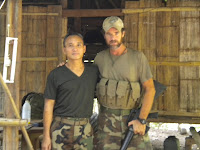I recently had to again answer the question of “why do you do it” to which I have never wavered in stating that quite simply…it’s the right thing to do! Based on news reports and intelligence coming out of the Burma I think the question that should have been asked is “why aren’t more people helping?”
Case in point…
Come to find out that the SPDC is now using political prisoners as objects on the battlefield to walk through minefields ahead of attacking forces. Now if you really want to see what this looks like go ahead and rent the last “Rambo” movie and prepare yourself. The movie opens with a scene from inside Burma of SPDC soldiers escorting political prisoners to a rice field and having them run across a mine laden area for sport. For those of you that have never seen or heard a land mine go off, this visual depiction is as close as you want to get to actually being there. Convict porters as they are now called are part of a broader problem of forced labor of political prisoners by the army in Burma, which the International Labor Organization has had some recent success in countering. Burma's military stands accused of deploying political prisoners as part of its long-standing “Four Cuts” strategy in restive ethnic minority regions, which tries to deny food, funds, intelligence and recruits to ethnic militias, but has resulted in hundreds of thousands of ethnic minority people fleeing their villages across the border to Thailand, or hiding out in the jungle. In 2007, the International Committee of the Red Cross, which recently regained some access to prisons in Burma after a five-year denial by the Burmese authorities, accused the Burmese government of major and repeated violations of international humanitarian law, adding that every year thousands of detainees have been forced to support the armed forces by serving as porters in combat.
And if that were not enough…
The government of Burma still champions a campaign of using children as soldiers within the SPDC. Despite international criticism and the SPDC’s creation of the Committee for Prevention of Military Recruitment of Underage Children, international reports state that the Burmese Army has not only failed to stop the recruitment and detention of children, but has actually increased these activities. As of mid-2011, the leading generals have required a quota of over 7,000 new recruits each month in efforts to build up the military, now around 500,000. Low pay and brutal treatment has previously hampered recruitment, but since the Saffron Revolution in 2007 even fewer men will join the forces voluntarily. Without men to recruit, and under the threat of serious punishment for failing to meet quota, more and more military officials are turning to children to fulfill their requirement. It is estimated that one in five soldiers is a child in Burma!
Recruitment can entail any number of tactics. Sometimes children join under economic and social pressure and other times they are coerced into service. A tactic becoming much more prevalent is enlistment under threat of jail or torture. Escapees have cited how they were apprehended in public places under the auspices of not having proper identification or loitering and then offered the chance of military service in lieu of going to jail. When these recruits fail the medical exam for growth deficiencies (height, weight, genital development), their captors will bribe the examiners to pass them in order to fulfill their quotas. Human Rights Watch reports that at other times officials will sell their recruits to different battalions or centers for anywhere between 25,000 and 50,000 kyat, a sum worth one and a half to three times or more the average monthly salary of an army private.
Once apprehended, child soldiers are detained until they can complete an 18-week basic military training program. These programs often involve strenuous physical labor, and recruits are beaten or otherwise severely punished for failing. After training, children are used for any number of jobs: cooks, porters, spies, etc, but most commonly in combat. Those who try to escape face the threat of death and those who do are generally caught shortly after and either imprisoned or re-enlisted. The Human Rights Education Institute of Burma reported that the extreme psychological abuse causes child soldiers to cry themselves to sleep in humiliation or attempt suicide either by themselves or by volunteering for the most dangerous of enlistments. Those who attempt to rationalize their war experiences distort their basic understandings of right and wrong. Children are normally only discharged in exchange for more recruits. In the end there is much to do…and yet not enough people to do anything about it. Hopefully some of you will join me…in one capacity or another. Take a look at the link below and ask yourself…”do I really want to sit at home and do nothing?” – I am sure many of you will feel just as I have...that a small, dedicated element can in fact make a difference
In the end there is much to do…and yet not enough people to do anything about it. Hopefully some of you will join me…in one capacity or another. Take a look at the link below and ask yourself…”do I really want to sit at home and do nothing?” – I am sure many of you will feel just as I have...that a small, dedicated element can in fact make a difference See you down range!
Brian

No comments:
Post a Comment